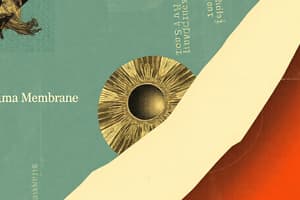Podcast
Questions and Answers
The cell membrane is fully permeable, allowing all substances to pass through without restriction.
The cell membrane is fully permeable, allowing all substances to pass through without restriction.
False (B)
The nucleus is responsible for ribosome assembly.
The nucleus is responsible for ribosome assembly.
False (B)
Mitochondria are often referred to as the 'powerhouses' of the cell because they generate ATP.
Mitochondria are often referred to as the 'powerhouses' of the cell because they generate ATP.
True (A)
Ribosomes are entirely composed of proteins, with no RNA involvement.
Ribosomes are entirely composed of proteins, with no RNA involvement.
The double membrane structure of the nucleus includes nuclear pores for transporting molecules.
The double membrane structure of the nucleus includes nuclear pores for transporting molecules.
Enzymes necessary for the electron transport chain are located on the outer membrane of the mitochondria.
Enzymes necessary for the electron transport chain are located on the outer membrane of the mitochondria.
Bound ribosomes synthesize proteins that are used only within the cell.
Bound ribosomes synthesize proteins that are used only within the cell.
The fluidity of the cell membrane is affected by temperature and lipid composition.
The fluidity of the cell membrane is affected by temperature and lipid composition.
Flashcards
Cell Membrane: What is it?
Cell Membrane: What is it?
The cell membrane acts as a gatekeeper, controlling what goes in and out of the cell. It's made of a phospholipid bilayer - a double layer of fats with heads facing outwards and tails inwards.
Nucleus: What does it do?
Nucleus: What does it do?
It's the control center of the cell, containing the DNA, which holds the instructions for making proteins and other important molecules.
Nuclear Envelope: What is it?
Nuclear Envelope: What is it?
The nucleus has a double membrane with pores that allow certain molecules to pass through.
Mitochondria: What is their function?
Mitochondria: What is their function?
Signup and view all the flashcards
Ribosomes: What is their role?
Ribosomes: What is their role?
Signup and view all the flashcards
Protein Synthesis: What is it?
Protein Synthesis: What is it?
Signup and view all the flashcards
Free vs. Bound Ribosomes: What's the difference?
Free vs. Bound Ribosomes: What's the difference?
Signup and view all the flashcards
Cell Membrane: Selective Permeability
Cell Membrane: Selective Permeability
Signup and view all the flashcards
Study Notes
Cell Membrane
- The cell membrane is a selectively permeable barrier enclosing the cell's contents.
- Primarily composed of a phospholipid bilayer, with embedded proteins and cholesterol.
- Hydrophobic tails of phospholipids face inward, hydrophilic heads face outward.
- This structure regulates substance passage into and out of the cell.
- Membrane proteins act as channels, pumps, receptors, and enzymes, influencing cell communication and transport.
- Membrane fluidity is crucial, affected by temperature and lipid composition.
- Maintains a concentration gradient, enabling active and passive transport.
Nucleus
- The nucleus is the cell's control center.
- Houses the cell's genetic material (DNA) organized into chromosomes.
- DNA is surrounded by proteins compacting and regulating access.
- Enclosed by a double membrane (nuclear envelope) with nuclear pores for molecule transport.
- Nucleolus within the nucleus is responsible for ribosome assembly.
- Regulates gene expression, influencing protein synthesis and cell activities.
Mitochondria
- Mitochondria are the "powerhouses" of the cell.
- Responsible for cellular respiration, generating ATP, the cell's primary energy currency.
- Possess their own DNA and ribosomes, suggesting an evolutionary origin as a separate organism.
- Double-membraned organelles, with an inner membrane folded into cristae for increased surface area.
- Cristae contain enzymes for the electron transport chain in cellular respiration.
- Mitochondrial malfunction significantly impacts energy production and overall cell health.
Ribosomes
- Ribosomes are the cell's protein synthesis machinery.
- Composed of ribosomal RNA (rRNA) and proteins.
- Can be free-floating in the cytoplasm or bound to the endoplasmic reticulum (ER).
- Free ribosomes synthesize proteins for use within the cell.
- Bound ribosomes synthesize proteins destined for secretion or membrane insertion.
- Protein synthesis involves tRNA (bringing amino acids) and mRNA (instructions).
Endoplasmic Reticulum (ER)
- The endoplasmic reticulum (ER) is a network of membranes throughout the cytoplasm.
- Continuous with the nuclear envelope, crucial for protein and lipid synthesis.
- Rough ER is studded with ribosomes, involved in protein synthesis and modification.
- Proteins synthesized on the rough ER often fold and modify within the ER lumen.
- Smooth ER lacks ribosomes, functions in lipid synthesis, detoxification, and calcium storage.
- The ER is involved in transporting molecules within the cell.
Studying That Suits You
Use AI to generate personalized quizzes and flashcards to suit your learning preferences.





